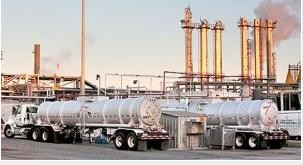Just weeks after an oil spill from Calumet Specialty Products Partners refinery seeped into a creek connected to the San Antonio River, over the weekend a second spill—from Calumet again—polluted the same river.
Screen shot via Calumet San Antonio Refinery
While transferring jet fuel to a rail truck Friday night, roughly 1,110 gallons spilled on the Southside refinery property, with 42 gallons escaping into the river. While they were aware of the spill, Calumet believed it was contained to their property and did not alert any outside authorities.
It wasn’t until 8:30 a.m. Saturday morning when a passerby, noticing a strange odor, contacted the San Antonio River Authority (SARA) and initiated the containment. The SA fire department hazmat crew, SARA and private environmental remediation companies hired by Calumet, began reversing the damage, with clean up ending noon Saturday.
“It is unfortunate folks weren’t informed on Friday when the spill had occurred,” River Authority spokesperson Stephen Schauer tells the Current. “But we certainly reacted as soon as we learned about the problem.”
Schauer says the previous (and larger) Calumet spill in early March, in which a estimated 6,550 gallons spilled on site with a (not yet specified yet said to be sizable) portion polluting a river tributary, shutting down Mission Parkway to cyclists and pedestrians, was similar in that clean up didn't start until a day later. Calumet’s failure to respond rapidly to contamination, more than once in a five-week period, is creating a troubling record, in the eyes of SARA. Schauer additionally points to the two fires that erupted at the refinery a few years back, also causing river contamination.
“It’s a pattern we don’t like happening at the River Authority. We certainly have higher expectations of how we think safety procedures should be implemented and how caution and action should be taken when things like this happen,” he says. “We expect Calumet to be good stewards of our river, especially being so close to Mission Reach. There really needs to be a higher standard of accountability here and I think San Antonio residents expect that as well.”
Following the March spill The People’s Power Coalition—a group that includes Fuerza Unida, Esperanza Peace and Justice Center, Southwest Workers Union, Bexar County Green Party and Students for Socioeconomic Justice at UTSA, as well as neighbors of the Calumet Refinery—petitioned city officials and the Texas Commission on Environmental Quality to “be transparent with the community” about the spill and answer questions about why the accident happened.
Marisol Cortez of Esperanza, speaking on behalf of the coalition, says the group is in the process of organizing action in response to the second spill. She drew attention to the link between the Eagle Ford Shale (the focus of an upcoming Esperanza informational art show): Calumet has recently expanded its operations and is expected to expand even further when a new pipeline is constructed later this year. The Indianapolis-based Calumet expects its jet fuel, diesel fuel and gasoline production to grow substantially. The ‘TexStar’ system will include 50 miles of pipeline from the Eagle Ford Shale in Karnes County to the Southeast side of San Antonio and is slated to bring in at least 10,000 barrels of fuel a day.
“By year-end 2014, the refinery will begin receiving significant volumes of Eagle Ford crude oil via the TexStar line, thereby enabling us to realize significant transportation cost savings on our delivered feedstock,” said Jennifer Straumins, COO of Calumet in a 2013 release.
The community has a “right to know how they will be impacted by the oil and gas boom taking place throughout South Texas,” the local coalition stresses.
After interviewing members of two Southside communities close to the refinery for a related environmental justice documentary, it became clear many of them felt nervous anticipating another spill, says Cortez.
“Every time things like this happen, neighborhoods get blockaded and people get evacuated,” she says. “They’re aware the refinery has this long history of accidents and they feel the impact. To varying degrees, it makes them anxious knowing not only that it could happen again, but that it’s likely to happen again.”
SARA has no regulatory authority (therefore, can’t penalize Calumet), so it’s now up to the Texas Commission on Environmental Quality to take any action, if necessary, against the refinery.
As of now, TCEQ is in the process of completing its incident report, which they’ve bundled with the March spill, given proximity in time between the two spills. When complete, TCEQ will determine whether to issue any penalties or fines from both incidents. As the River Authority awaits a final report, they hope to seek reimbursement for expenses for time and staff and investment back into the watershed from possible dollars fined.


















